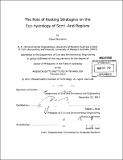| dc.contributor.advisor | Rafael L. Bras. | en_US |
| dc.contributor.author | Sivandran, Gajan | en_US |
| dc.contributor.other | Massachusetts Institute of Technology. Dept. of Civil and Environmental Engineering. | en_US |
| dc.date.accessioned | 2012-05-15T21:10:25Z | |
| dc.date.available | 2012-05-15T21:10:25Z | |
| dc.date.copyright | 2011 | en_US |
| dc.date.issued | 2012 | en_US |
| dc.identifier.uri | http://hdl.handle.net/1721.1/70762 | |
| dc.description | Thesis (Ph. D.)--Massachusetts Institute of Technology, Dept. of Civil and Environmental Engineering, February 2012. | en_US |
| dc.description | Cataloged from PDF version of thesis. | en_US |
| dc.description | Includes bibliographical references (p. 193-205). | en_US |
| dc.description.abstract | Arid regions are characterized by high variability in the arrival of rainfall, and species found in these areas have adapted mechanisms to ensure the capture of this scarce resource. In particular, the rooting strategies employed by vegetation can be critical to their survival. However, land surface models currently prescribe rooting profiles as a function of only the plant functional type of interest with no consideration for the soil texture or rainfall regime of the region being modeled. Additionally, these models do not incorporate the ability of vegetation to dynamically alter their rooting strategies in response to transient changes in environmental forcings or competition from other plant species, and therefore tend to underestimate the resilience of these ecosystems. To address the simplicity of the current representation of roots in land surface models, a new dynamic rooting scheme was incorporated into the framework of the distributed ecohydrologic model tRIBS+VEGGIE. The new scheme optimizes the allocation of carbon to the root zone to reduce the perceived stress of the vegetation, so that root profiles evolve based upon local climate and soil conditions. The strength of this scheme lies in its ability to optimize the rooting profile in a computationally-efficient manner, without requiring additional parameterization by the model user. The ability of the new scheme to capture the complex dynamics of natural systems was evaluated by comparisons to hourly-timescale energy flux, soil moisture and vegetation growth observations from the Walnut Gulch Experimental Watershed, Arizona. Very good agreement was found between the model and observations, providing confidence that the improved model is able to capture the multidirectional interactions between climate, soil and vegetation at this site. The power of the new scheme was demonstrated through simulation of observed forms of within-hillslope vegetation patterning and the model's ability to represent competition-colonization dynamics between different plant functional types under non-equilibrium conditions. | en_US |
| dc.description.statementofresponsibility | by Gajan Sivandran. | en_US |
| dc.format.extent | 275 p. | en_US |
| dc.language.iso | eng | en_US |
| dc.publisher | Massachusetts Institute of Technology | en_US |
| dc.rights | M.I.T. theses are protected by
copyright. They may be viewed from this source for any purpose, but
reproduction or distribution in any format is prohibited without written
permission. See provided URL for inquiries about permission. | en_US |
| dc.rights.uri | http://dspace.mit.edu/handle/1721.1/7582 | en_US |
| dc.subject | Civil and Environmental Engineering. | en_US |
| dc.title | The role of rooting strategies on the eco-hydrology of semi-arid regions | en_US |
| dc.type | Thesis | en_US |
| dc.description.degree | Ph.D. | en_US |
| dc.contributor.department | Massachusetts Institute of Technology. Department of Civil and Environmental Engineering | |
| dc.identifier.oclc | 788626448 | en_US |
